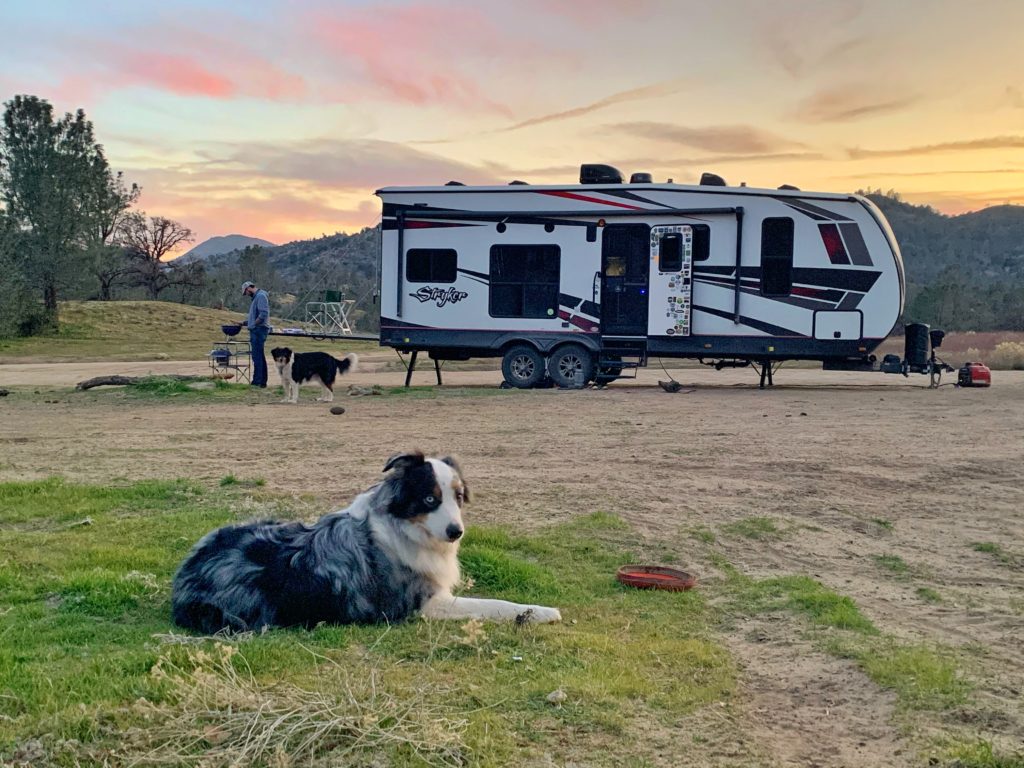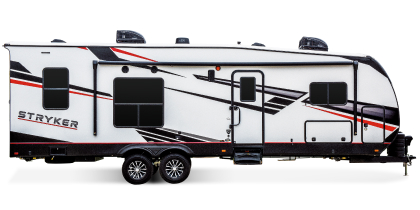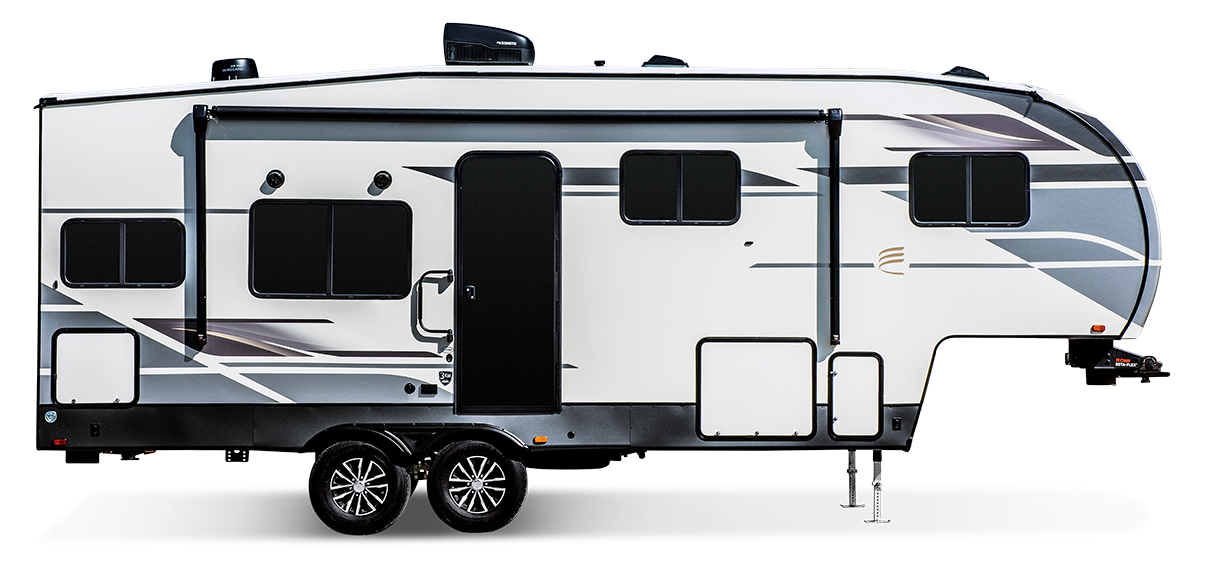My husband Matt and I were feeling stagnant. We were seemingly “just going through the motions” at home, in our jobs and in the daily grind of life. But one night in January 2017, we had just finished watching a documentary film on minimalism when we realized we could live that life, too. We started talking about downsizing, our jobs and what could be possible for us, and soon after, the idea of living in an RV and potentially boondocking while traveling across the United States was born.
Matt and I both enjoy tent camping, but neither of us had ever stepped foot inside an RV before. Regardless, we were determined that this was the right path for us. So after 18 months of extremely focused planning and saving, we made the switch to full-time RV life.
Our travels have taken us from coast to coast, with lots of zigzagging in between. We have hiked in countless national parks, kayaked in Canada, and visited family in remote corners of the country. Thanks to RVing, we have lived among the mountains, rivers, canyons, beaches, forests, and deserts. And through all of this, Matt and I discovered that we love boondocking and will take any opportunity we can to camp this way.
Boondocking is a term used to describe RV camping in more remote places where there are very limited or zero amenities (i.e. no connection to water, power or sewer). The solitude provides a stress-free environment, the open landscapes provide plenty of space for our dogs to play, and the privacy allows us to sit on our back patio and enjoy the warm breeze. And that stagnant feeling from before? Totally gone.

Since starting our lives on the road, we’ve done quite a bit of boondocking—sometimes camping this way for weeks at a time. Whether you travel in your RV full-time, part-time or are a weekend warrior, anyone can boondock! We are sharing some of our insights on boondocking: the escape everyone should know.
BEST TIPS FOR GOING OFF THE GRID, AND GETTING TO ACHIEVE SOME PEACE AND SOLITUDE
1. Why do you prefer boondocking over traditional hook-ups?
We prefer boondocking for several reasons. It’s free, secluded and provides us with a true escape to nature. It is why we transitioned to the RV lifestyle in the first place—to have the most beautiful and serene landscapes right in our backyard! Boondocking is also an exciting adventure for our pets. With so much open space, they have more room to run, can explore new smells and play for hours.
We actually chose our Stryker toy hauler specifically because we knew we wanted to boondock a lot. Toy haulers are ideal for long-term boondocking because not only can you fully enjoy the incredible views from your back patio, but they are built with heavier axles that allow you to carry more weight.
2. What steps do you take to prepare for a boondocking trip?
Researching the exact spot and roads leading to your boondocking location is important. After settling on a place, we always empty our tanks and then fill our freshwater tank with potable water. We’ll also stock up on some extra drinking water and store it in the truck. If we know we’ll be far from a town (more than 20 miles usually), we like to get all of our groceries bought, prepped and stored ahead of time.
If you have any portable battery packs, make sure those are all charged before you leave. Weather is also a big factor when it comes to boondocking. Before heading out, we not only check weather forecasts but also wind conditions on an app called Windy. This is really important, especially if you have a towable unit like we do. Lastly, it’s always a good idea to bring some basic roadside safety gear and repair tools in case anything happens with your tow vehicle.
3. How do you find boondocking spots? What resources do you use?
We take a lot of time and do detailed research in order to find our boondocking sites. There are a few strategies and websites we recommend. First, we always consider our priorities. Our number one priority is usually cell service, since we rely on it for our remote jobs. Your cell phone or data provider can usually share where their coverage extends, and you can often find detailed coverage maps online.
Some other priorities might include wanting to see a certain national park, being close to a specific town, or trying a particular activity such as fly fishing or rock climbing. Determining our priorities before we leave helps us narrow our search and focus on our “must-haves.”
Boondocking Apps We Use
Most of our boondocking sites are found through Campendium, a website and free app that provides detailed campsites reviews written by actual campers. We’ll supplement our research with other websites, including Google Maps, the National Forest Foundation, Bureau of Land Management, and Free Campsites. These are good resources for boondocking guidelines, including length of stay (usually 14 days) and how far apart you have to park from another boondocker (general rule of thumb is 1,000 feet).
Additionally, some of our favorite boondocking apps are Ultimate US Public Campgrounds, Allstays, iOverlander, and Harvest Hosts. These are all great for finding location-specific boondocking spots, such as on farms and wineries.


4. What features should you look for in an RV to make it ideal for boondocking?
Truthfully, you can boondock with any self-contained RV, but some are better suited for long-term boondocking than others. In our opinion, the most important features to consider are tank size, power options, length and ground clearance. Toy haulers were never on our radar since we don’t own any “toys,” but after accidentally stumbling into one, we realized that the features they offer were exactly what we needed.
Our freshwater tank is 100 gallons, while the grey and black tanks are 45 gallons each. We have high ground clearance, which is extra beneficial for driving on rocky, bumpy roads that often come along with boondocking territory. Our toy hauler also came with an onboard generator and its own gas-filling station. This filling station is typically used to refill the toys but for us, it’s ideal to refill our generators. And hands down, our favorite feature is the back patio! Our favorite way to end the day is sitting outside on our patio, overlooking a fiery sunset, with a cold craft brew in hand.

5. What advice do you have for boondocking with pets?
Our biggest piece of advice for boondocking with pets is to make sure you pack enough food and water. Pack even more than you think you might need. For example, if you plan to be boondocking for five days, measure out five days’ worth of food for your pet and then add an extra day or two. Be sure to also have a basic pet first aid kit and a copy of each animal’s latest medical records. Much like Matt and I are always aware of the closest hospital when we travel, we do the same for veterinarians.
Air conditioning and heating capabilities are also some things to consider when boondocking with pets. If you must leave the RV for an extended period of time while boondocking, make sure the temperature in your RV is safe for your pets or bring them with you.
And lastly, when you’re boondocking, never forget that you are staying in remote wilderness and likely sharing the space with wildlife. Always be aware of your surroundings and understand what types of local animals could be threats to your pets, including the smaller animals like bugs and ticks. Pro tip: Did you know there is a rattlesnake vaccine for pets? If you are boondocking in rattlesnake territory, this is a great option.
6. How do you manage internet connectivity while boondocking?
We rely on the internet for our remote jobs, so cell service and internet connectivity are always our first priorities when searching for boondocking spots. We connect to the internet through our hotspot devices and have two network providers—T-Mobile and Verizon. T-Mobile is our cell phone provider, which offers hotspot data through our phones. We also have a Verizon Jetpack Mobile Hotspot to help give us some extra coverage.
Before settling on a boondocking spot, we research whether it will have service by checking Campendium reviews or checking our provider’s nation-wide coverage maps. Our service provider’s interactive map is extremely helpful, and you can even put in specific GPS coordinates. We’ve also come to learn that if you boondock within 20 miles of a town or city, there’s a much better chance you’ll have service.
But if we don’t have service or the signal just isn’t strong enough for our needs, we’ll use our WeBoost and omni-directional trucker antenna to help. It’s important to know that service in these types of remote areas is never guaranteed, so always have a back-up plan.


7. What is your ideal duration of a boondocking adventure? What pro tips do you have for others to extend their boondocking stay?
Our ideal boondocking adventure is two weeks, which is typically the longest consecutive amount of time allowed at national forests or Bureau of Land Management (BLM) land. However, we have boondocked for several months at a time, moving from spot to spot and dumping and refilling our tanks in between. Power and water are key to extending your off-grid adventures.
For our power needs, we currently use a generator but are considering adding solar panels as well. Another great tip for power usage is purchasing a portable power station that can be charged ahead of time. This type of station is perfect for powering electronics like laptops, cell phones, even small TVs.
Conserving Water While Boondocking
Through our years of boondocking, we’ve also collected some great water-conservation tips. First, take minimal, military-style showers. This means five minutes or less. It helps to replace your shower head with one that is low-flow and has a water shut-off valve. Second, use a pre-filled spray bottle to do dishes and try hand sanitizer in lieu of handwashing. Third, bring your own drinking water and keep that separate from your washing water.
We like to use reusable six-gallon water jugs instead of the single-use plastic jugs. And lastly, flex your cooking muscle and try making one-pot or one-pan meals. This will reduce the number of dishes you have to do and ultimately save you more water.
8. What steps do you need to take after a boondocking trip?
Because most boondocking spots are national forests, state parks or BLM land, it is important to leave the spot better than you found it—you want it to seem like you were never even there. For us, that means anything we bring to the boondocking site, we must take with us. This includes obvious things like trash, but also leftover wood or ash from a fire and replacing any rocks or logs that we might’ve moved during our stay.
When our boondocking trip is over, we immediately find the closest place to dump our grey and blackwater tanks. If we have a campground reserved for our next stay and it’s not too far of a drive, we’ll often just dump our tanks there. We don’t like to travel with full tanks because it lowers our gas mileage and can start to smell after a long drive.

9. Where are some of your favorite locations to boondock for extended periods of time?
Keysville North Recreation Site in Lake Isabella, California, has a great off-road vehicle area. The site is right along the Kern River, and there is plenty of adventure in the nearby town of Kernville—an adorable and quaint, old Western town.
Boondocking Locations
There are a few boondocking options near Grand Teton National Park in Jackson Hole, Wyoming, all with incredible views of the mountains. The most recent spot we stayed at near here is called Shadow Mountain National Forest Campground. It’s free and only about 15 minutes away from the park. This campground does get crowded in the summer, so try to arrive early in the day and secure a good spot.
While exploring all of the many parks in Utah, we stayed on some BLM land near Capitol Reef National Park. The spot had amazing panoramic views and was only 10 minutes from the park’s main entrance. With towering red rocks and jagged vistas, it was an ideal place to sit back and take in the breathtaking views.
While boondocking may not be as easy as simply pulling in and plugging in, the views and serenity you’ll experience make all of the planning, researching and preparing totally worth it. And if you plan to stay off the grid for an extended period of time, just make sure you have enough water and power to support your stay. Oh, and don’t forget to pack extra dog treats.
This story first appeard on THOR Industries









